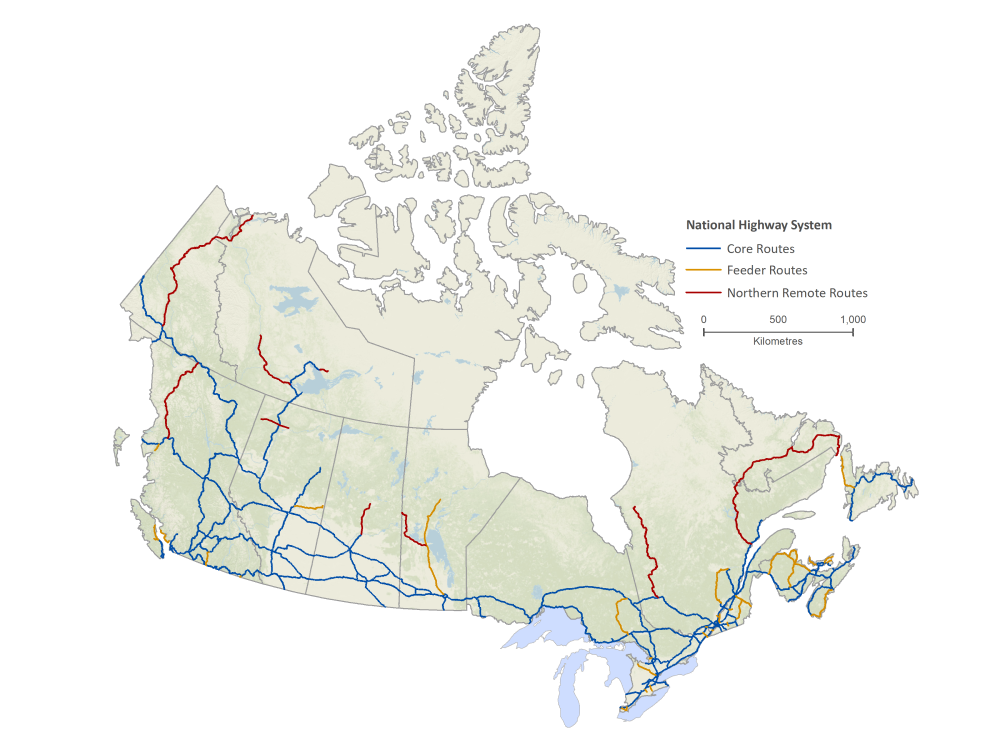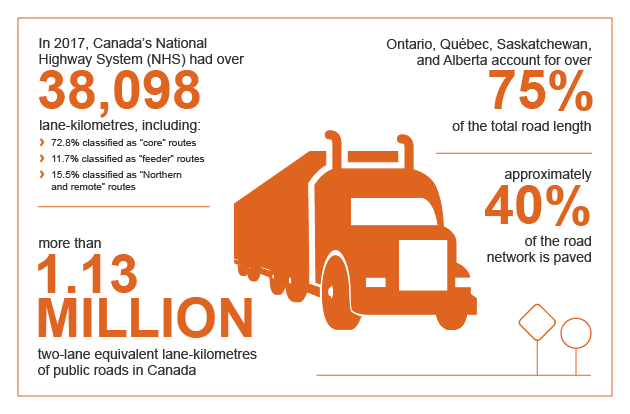Image description - Road Transportation Network
The map of Canada shows the location of the NHS. The NHS includes over 38,000 kilometers of Canada’s most important highways from coast to coast. Core routes (which represent 72.8 per cent of the NHS) are illustrated by blue lines, Feeder routes (which represent 11.7% of the NHS) by orange lines and Northern and Remote routes (which represent 15.5 per cent of the NHS) by red lines.
Road transportation is the dominant mode for moving both freight and passengers across Canada. Canada is connected from the Pacific to Atlantic coasts by a network of connecting highways anchored by the Trans-Canada Highway. Canada also has extensive road networks across its southern, more populated areas.
As shown on Map 8 in Annex, the system consists mainly of interprovincial and international road links.
In 2019, 25.4 million road motor vehicles were registered in Canada, up 1.4% from 2018 and 16.4% from a decade ago.
- Around 92% were vehicles weighing less than 4,500 kilograms, mainly passenger automobiles, pickups, SUVs and minivans
- 4.4% were medium and heavy trucks weighing 4,500 kilograms or more, and
- 3.3% were other vehicles such as buses, motorcycles and mopeds
As of December 2020, there were 232,680 businesses whose primary activity was trucking transportation, 72,369 with employees and 160,311 without employees. The trucking industry includes many small for-hire carriers and owner-operators, and some medium and large for-hire companies that operate fleets of trucks and offer logistic services. Trucking companies were mainly concentrated in 4 provinces: Ontario (45.5%), Quebec (17.9%), Alberta (13.8%), and British Columbia (12.3%).
Image description - Road Transportation infographic
In 2017, Canada’s National Highway System (NHS) had over 38,098 lane-kilometres, including:
- 72.8% classified as “core” routes
- 11.7% classified as “feeder” routes
- 15.5% classified as “Northern and remote” routes
Canada also had
- More than 1.13 million two-lane equivalent lane-kilometres of public road in Canada
- Ontario, Québec, Saskatchewan, and Alberta account for over 75% of the total road length
- Approximately 40% of the road network is paved
The trucking industry is involved in 3 main types of trucking activities:
- for-hire trucking services, which fall into 2 main categories:
- “less-than truckload”, meaning to transport relatively small-sized freight from different shippers in a truck
- “truckload”, meaning to transport a shipment from a single shipper in a truck
- courier operators, which specialize in transporting parcels. As of December 2020, 18,211 companies had courier or messenger services as their main line of business
- private carriers, where businesses maintain a fleet of trucks and trailers to carry their own goods, such as Walmart and Costco. Transport Canada does not currently track this part of the trucking industry (as it was not the primary activity of these non-transportation companies)

